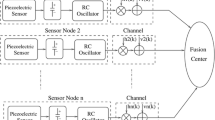Abstract
Smart sensing technologies play a key role in the core of smart systems, which form the rapidly evolving internet of things. In this context, buildings’ occupancy information is an important input that allows smart systems to be seamlessly aware of and responsive to the inhabitants, thus ensuring their comfort. Ultrasonic motion sensors are used to obtain occupancy information of indoor spaces. Although they provide a high accuracy as compared to other sensors, like Passive InfraRed, they require a higher power consumption. In this work, we propose an adaptive power switching technique, which we call power hopping. This technique allows ultrasound motion sensors to optimize their transmitter power level, in order to best fit their surrounding environment. The objective is to reduce the overall energy consumption of these sensors. We have tested our method using a sensor prototype, and the results show that, depending on the sensor’s environment, a possible saving in the transmitter power can be achieved, which reached up to 78% in our experiments. We also derive an upper bound limit of the method’s convergence time, and we propose an automatic sensing method to detect potential changes in the sensor’s environment.








Similar content being viewed by others
References
Akyildiz IF, Su W, Sankarasubramaniam Y, Cayirci E (2002) A survey on sensor networks. IEEE Commun Mag 40(8):102–114. https://doi.org/10.1109/MCOM.2002.1024422 (ISSN 0163-6804)
Caicedo D, Pandharipande A (2012) Ultrasonic arrays for localized presence sensing. IEEE Sens J 12(5):849–858. https://doi.org/10.1109/JSEN.2011.2161667 (ISSN 1530-437X)
Gonzalez LIL, Großekathöfert U, Amft O (2014) Novel stochastic model for presence detection using ultrasound ranging sensors. In: 2014 IEEE international conference on pervasive computing and communications workshops (PERCOM Workshops). pp. 55–60. https://doi.org/10.1109/PerComW.2014.6815164
Guo X, Tiller DK, Henze GP, Waters CE (2010) The performance of occupancy-based lighting control systems: a review. Light Res Technol 42(4):415–431
Hammoud A, Deriaz M, Konstantas D (2016) Robust ultrasound-based room-level localization system using cots components. In: 2016 Fourth international conference on ubiquitous positioning, indoor navigation and location based services (UPINLBS). pp 11–19. https://doi.org/10.1109/UPINLBS.2016.7809975
Hammoud A, Kyritsis AI, Deriaz M, Konstantas D (2017a) Enhanced still presence sensing with supervised learning over segmented ultrasonic reflections. In: 2017 International conference on indoor positioning and indoor navigation (IPIN), pp 1–8. https://doi.org/10.1109/IPIN.2017.8115920
Hammoud A, Anagnostopoulos G, Kyritsis A, Deriaz M, Konstantas D (2017b) Power hopping: an automatic power optimization method for ultrasonic motion sensors. In: The 14th IEEE international conference on ubiquitous intelligence and computing, ’17, San Francisco, California
Hammoud A, Deriaz M, Konstantas D (2017c) Ultrasense: A self-calibrating ultrasound-based room occupancy sensing system. Procedia Computer Science, 109(Supplement C):75–83, 2017c. ISSN 1877-0509. https://doi.org/10.1016/j.procs.2017.05.297. 8th International Conference on Ambient Systems, Networks and Technologies, ANT-2017 and the 7th International Conference on Sustainable Energy Information Technology, SEIT 2017, 16-19 May 2017, Madeira, Portugal
Jaramillo P, Linnartz JP (2015) Hidden Markov model for improved ultrasound-based presence detection. In: 2015 IEEE international conference on computer and information technology; ubiquitous computing and communications; dependable, autonomic and secure computing; pervasive intelligence and computing (CIT/IUCC/DASC/PICOM). pp 68–74. https://doi.org/10.1109/CIT/IUCC/DASC/PICOM.2015.14
Kuutti J, Saarikko P, Sepponen RE (2014) Real time building zone occupancy detection and activity visualization utilizing a visitor counting sensor network. In: 2014 11th international conference on remote engineering and virtual instrumentation (REV). pp 219–224. https://doi.org/10.1109/REV.2014.6784260
Lindsey S, Raghavendra CS (2002) PEGASIS: power-efficient gathering in sensor information systems. IEEE Aerosp Conf Proc 3:3-1125–3-1130. https://doi.org/10.1109/AERO.2002.103524
Luo X, Liu T, Shen B, Gao L, Luo X (2016) Human indoor localization based on ceiling mounted pir sensor nodes. In: 2016 13th IEEE Annual consumer communications networking conference (CCNC). pp. 868–874. https://doi.org/10.1109/CCNC.2016.7444903
Mehmood A, Sabatier JM, Bradley M, Ekimov A (2010) Extraction of the velocity of walking human’s body segments using ultrasonic Doppler. J Acoust Soc Am 128(5):EL316–EL322. https://doi.org/10.1121/1.3501115
Mishra P, Shankar HN, Mathur M (2009) An ultra-low power real time embedded system for map generation using ultrasound sensors. In: 2009 Third UKSim European symposium on computer modeling and simulation. pp. 579–584. https://doi.org/10.1109/EMS.2009.87
Mokhtari G, Zhang Q, Nourbakhsh G, Ball S, Karunanithi M (2017) Bluesound: a new resident identification sensor–using ultrasound array and ble technology for smart home platform. IEEE Sens J 99:1–1. https://doi.org/10.1109/JSEN.2017.2647960 (ISSN 1530-437X)
Narayana S, Prasad RV, Rao VS, Prabhakar TV, Kowshik SS, Iyer MS (205) Pir sensors: characterization and novel localization technique. In Proceedings of the 14th international conference on information processing in sensor networks, IPSN ’15, ACM, New York, NY, USA. pp.142–153, ISBN 978-1-4503-3475-4. https://doi.org/10.1145/2737095.2742561
Pottie GJ, Kaiser WJ (2000) Wireless integrated network sensors. Commun ACM 43(5):51–58. https://doi.org/10.1145/332833.332838 (ISSN 0001-0782)
Raj B, Kalgaonkar K, Harrison C, Dietz P (2012) Ultrasonic Doppler sensing in HCI. IEEE Pervasive Comput 11(2):24–29. https://doi.org/10.1109/MPRV.2012.17 (ISSN 1536-1268)
Shnayder V, Hempstead M, Chen BR, Allen GW, Welsh M (2004) Simulating the power consumption of large-scale sensor network applications. In Proceedings of the 2nd international conference on embedded networked sensor systems, SenSys ’04, ACM, New York, NY, USA. pp 188–200. ISBN 1-58113-879-2. https://doi.org/10.1145/1031495.1031518
Teixeira T, Dublon G, Savvides A (2010) A survey of human-sensing: methods for detecting presence, count, location, track, and identity. ACM Comput Surv 5(1):59–69
Yin J, Fang M, Mokhtari G, Zhang Q (2016) Multi-resident location tracking in smart home through non-wearable unobtrusive sensors. Springer, Cham, pp 3–13. https://doi.org/10.1007/978-3-319-39601-9-1 (ISBN 978-3-319-39601-9)
Author information
Authors and Affiliations
Corresponding author
Additional information
Publisher’s Note
Springer Nature remains neutral with regard to jurisdictional claims in published maps and institutional affiliations.
This work was co-funded by the State Secretariat for Education, Research and Innovation of the Swiss federal government and the European Union, in the frame of the EU AAL project EDLAH2 (aal-2015-022) and the AAL project ManyMe (aal-2016-063).
Rights and permissions
About this article
Cite this article
Hammoud, A., Deriaz, M. & Konstantas, D. Adaptive power switching technique for ultrasonic motion sensors. J Ambient Intell Human Comput 9, 1635–1645 (2018). https://doi.org/10.1007/s12652-018-0888-y
Received:
Accepted:
Published:
Issue Date:
DOI: https://doi.org/10.1007/s12652-018-0888-y




